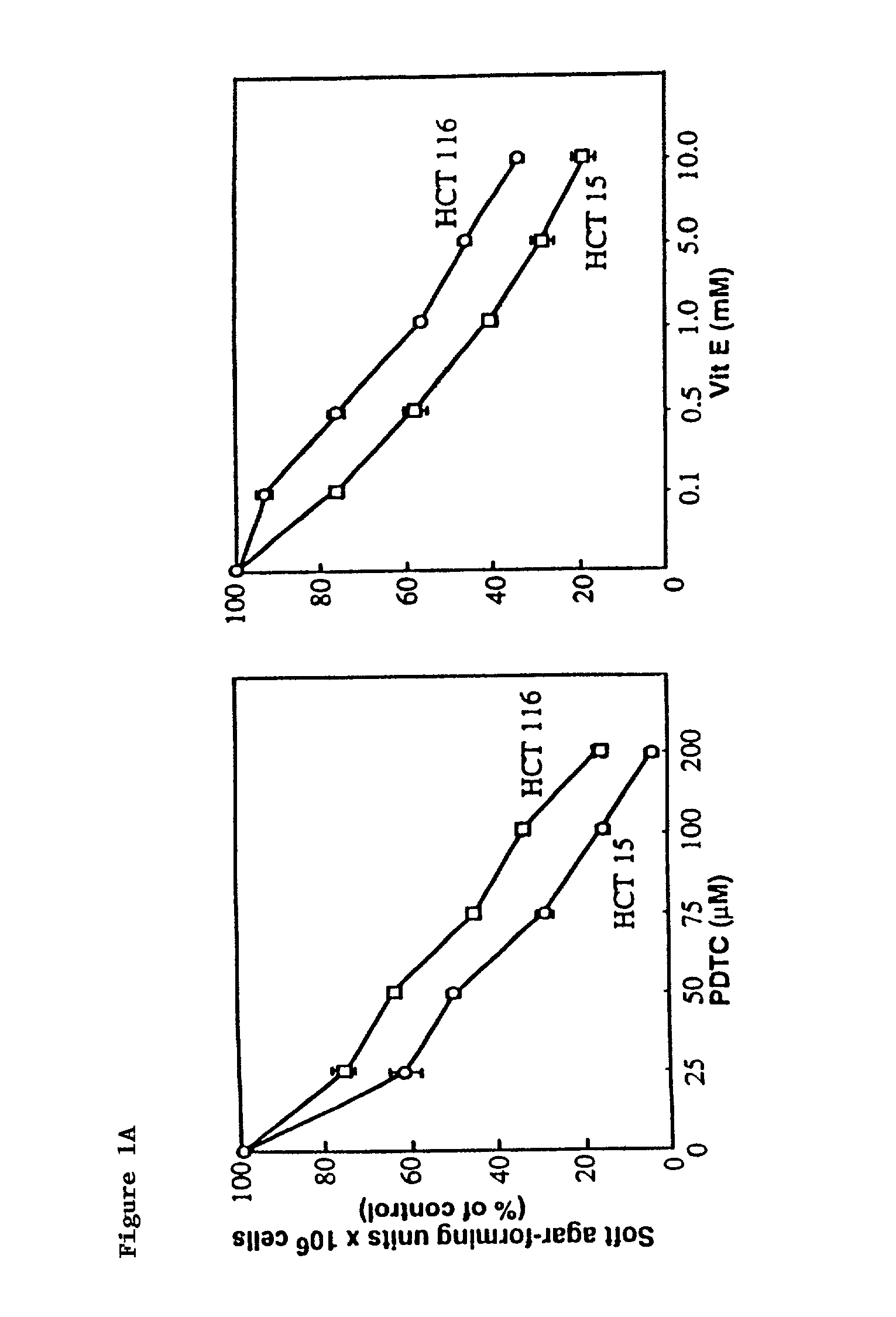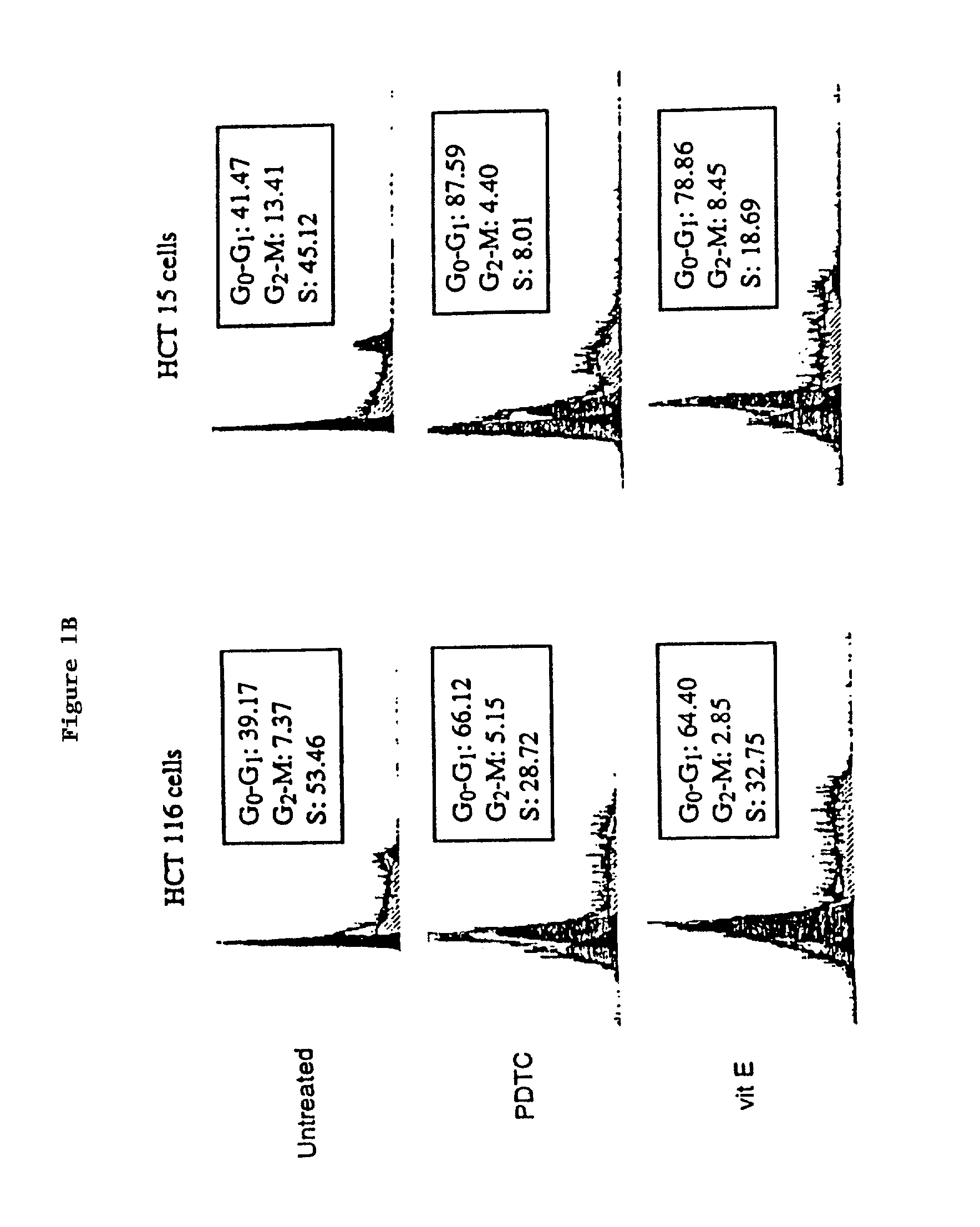Antioxidant enhancement of therapy for hyperproliferative conditions
a technology of anti-proliferative conditions and anti-oxidant enhancement, which is applied in the field of medicinal chemistry, can solve the problems of limited clinical utility of fluoropyrimidines, tumors lacking functional p53 are frequently refractory, and not all intolerant patients showed reduced dihydrouracil dehydrogenase activity, etc., to reduce pp2a enzymatic dephosphorylation, prevent dephosphorylation, and reduce methylcarboxylation
- Summary
- Abstract
- Description
- Claims
- Application Information
AI Technical Summary
Benefits of technology
Problems solved by technology
Method used
Image
Examples
example 1
[0164]HCT 116 and HCT 15 human CRC cells were obtained from the American type Culture Collection. p21WAF1 / CIP1− / − cancer cells generated from HCT 116 cells by T. Waldman were provided by J. Pietenpol (Vanderbilt University, Tenn.) and HPV E6-transfected HCT 116 by W. S. E1-Deiry (University of Pennsylvania, Pa.) [W. S. El-Deiry et al., Cell 75, 817 (1993)]. All cancer cell lines used in these studies were grown in Dulbecco's modified Eagle's medium (DMEM) (GIBCO BRL) with high glucose and supplemented with 10% heat-activated fetal bovine serum (FBS), non-essential amino acids, L-glutamine, and penicillin G Sodium (100 U / ml) and streptomycin sulfate (100 mg / ml) at 37° C. in 5% CO2 in air.
[0165]To determine the effect of pyrrolidinedithiocarbamate (Sigma Chemical Co., Ma.), a vitamin E analogue (6-hydroxy-2.5,7,8-tetramethylchroman-2-carboxylic acid: vit (E) (Aldrich), 5-FU (Hoffmann-LaRoche Inc. Nutley, N.J.) or doxorubicin (Sigma) on anchorage-independent growth, HCT 15 and HCT 116 ...
example 2
[0166]DNA Content of nuclei was determined as described [I. G. Nicoletti et al., J Immunol. Methods. 139, 271 (1991)] by lysing plasma membranes, staining nuclear DNA with propidium iodide (50 mg / ml), and quantitating the relative DNA content of nuclei using the Becton Dickinson FACSORT fluorescence-activated cell sorter. The proportion of nuclei in each phase of the cell cycle was determined using MODFIT-DNA analysis software. Detection of apoptotic cells either by fluorescence microscopy or by flow cytometry was performed using the ApopTag Plus In Situ Apoptosis Detection Kit (Oncor, Gaithersburg, Md.) as described in the manufacturer's protocol. Briefly, gigoxygenin-labeled nucleotides were added to free 3′OH groups of DNA produced by DNA fragmentation during apoptosis by terminal deoxynucleotidyl transferase (TdT). Digoxygenin was detected by a FTC-conjugated anti-digoxygenin antibody. Analysis was carried out using the fluorescence-activated cell sorter and FITC staining visual...
example 3
[0167]Intracellular H2O2 levels were analyzed by flow cytometry using dihydrorhodamine 1234 (DHR) as a specific fluorescent dye probe [G. Rothe, A. Emmendorffer, A. Oser, J. Roesler, G. Valet, J Immun. Methods 138, 133 (1991); J. A. Royall, H. Ischiropoulos, Arch. Biochem. Biophysics 302, 348 (1993)]. CRC cells were grown in DMEM containing 1 mM DHR and pyrrolidinedithiocarbamate (70 μM) or vit E (3 mM) for up to 24 hours. Following trypinization, trypsin activity was quenched with 2% FBS in phosphate buffered saline and cells fixed in 1% paraformaldahyde (Sigma). Cellular rhodamine 123 fluorescence intensity of 1×104 cells was measured for each sample using a Becton-Dickenson FACS Vantage flow cytometer with the excitation source at 488 nm and emission wave length of 580 nm. Histograms were analyzed with the software program PC-Lysis (Becton Dickenson). Background fluorescence from blank wells was subtracted from each reading.
PUM
| Property | Measurement | Unit |
|---|---|---|
| pH | aaaaa | aaaaa |
| time | aaaaa | aaaaa |
| temperature | aaaaa | aaaaa |
Abstract
Description
Claims
Application Information
 Login to View More
Login to View More - R&D
- Intellectual Property
- Life Sciences
- Materials
- Tech Scout
- Unparalleled Data Quality
- Higher Quality Content
- 60% Fewer Hallucinations
Browse by: Latest US Patents, China's latest patents, Technical Efficacy Thesaurus, Application Domain, Technology Topic, Popular Technical Reports.
© 2025 PatSnap. All rights reserved.Legal|Privacy policy|Modern Slavery Act Transparency Statement|Sitemap|About US| Contact US: help@patsnap.com



